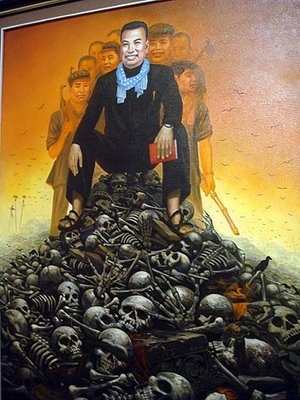Survival art
 Hen Sophal's The Khmer Rouge Leader painting
Hen Sophal's The Khmer Rouge Leader paintingThese two works represent the divergent perspectives of different generations of Cambodians on Pol Pot and his killing fields, and lie at the heart of "Art of Survival," a group exhibition at the contemporary art space Meta House in Phnom Penh. The exhibit is a "long-overdue dialogue through art" that seeks to address modern memories of Cambodia's painful past, says Meta House director Nico Mesterharm. The two-part exhibition began in January with 21 artists and expanded this month to include a total of 40 artists, who were each given a blank canvas to document their reflections on the Khmer Rouge period. The show was scheduled to coincide with current efforts to bring former Khmer Rouge leaders to justice through a U.N.-assisted genocide tribunal, which is preparing for its first trial—of Kaing Guek Eac, the former commander of the notorious S-21 prison and torture center—next month. The exhibit includes international artists such as Vietnamese-Khmer painter Le Huy Hoang, who painted a portrait of his father, a Cambodian military doctor who died in one of Pol Pot's detention camps, and the American Bradford Edwards, who has regularly traveled to Cambodia over the past 12 years. "We're trying to show the impact of the genocide not just on Cambodia but on the region as well," says Lydia Parusol, art manager of Meta House.
Pol Pot's Khmer Rouge presided over the deaths of almost 2 million Cambodians between 1975 and 1979. But their presence was felt long after they were overthrown 10 years ago. The Southeast Asian nation's culture was nearly wiped out during that time, and though the new government sought to rebuild the arts, it placed more emphasis on traditional dance and theater than on contemporary art. Indeed, most artists have been extremely reluctant to confront the past, notes Hen, admitting that he painted "The Khmer Rouge Leader" in 2000 but was afraid to show the work in public for fear of "retribution." "Everybody knows this happened to Cambodia, so actually, some artists feel they don't need to paint [it]," he says. "But I think about the Khmer Rouge all the time. It's in my head; it's an obsession." The works on display are clearly skewed by age. Older artists who survived the regime, like Hen, Chhim Sothy and Vann Nath, tend to show more graphic depictions of the Khmer Rouge, with skulls and death crowding canvases. Vann's untitled oil painting, which depicts a group of blindfolded prisoners with ropes around their necks being led inside the S-21 prison, is made more poignant by the knowledge that the artist is only one of a handful of remaining survivors from the torture center, where nearly 20,000 people are believed to have been tortured and killed. Since the end of the Khmer regime, Vann is probably the only painter to have continuously depicted in great detail the atrocities of the regime. Some of his works are on permanent display at the Phnom Penh prison, which has been turned into the Tuol Sleng Genocide Museum.
The younger generation favors more abstract works. Tith Veasna's "Blind Pins" is a mixed-media installation using pins and black fabric—a Cambodian symbol of mourning for a relative who dies. Vandy Rattana's "Going Fanatic" is a photograph of squares of light around a hammer and sickle. "It's not that the younger generation is forgetting," Vandy says. "It's just that we don't know much about it. After 12 years of school, I'd never heard about the Khmer Rouge." Perhaps the most powerful painting is by the rising contemporary-art star Leang Seckon, whose "My Shadow" depicts a half-naked man whose mirrored reflection shows a skeleton. The man, which the artist imagines as part of Pol Pot's regime, is throwing a punch at his shadow as if wrestling with his own demons. "This man knows his guilt," says Leang. "He can hide it outside, but the mirror shows his true self." In the same way, "Art of Survival" is an unflinching reflection of Cambodia's attempts to reconcile the past.


0 Comments:
Post a Comment
<< Home